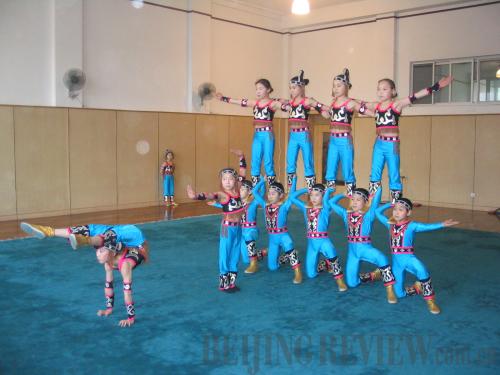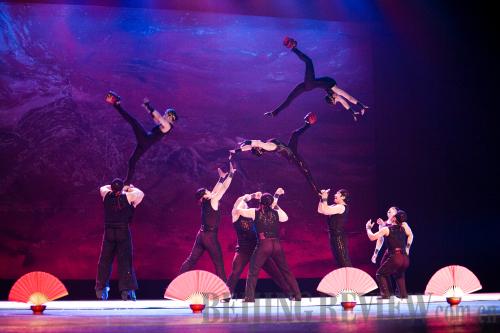|
 |
|
TOMORROW'S STARS: Russian students train hard at the Beijing International Arts School (COURTESY OF CHINA NATIONAL ACROBATIC TROUPE) |
Di Hui, now 21, is one of the principal CNAT acrobats and has been successful because of her love to the art and strong willpower in training.
When Di came to Beijing from her hometown Harbin to audition 10 years ago, she was almost refused by Sun because of her age—she was a little bit older than the required age. But Di's indomitable spirit and dedication to acrobatics finally moved all the teachers and gained her an opportunity for a three-month probation.
Di was assigned to an experienced teacher, Zhou Yuexiang, to learn the art of contortion, an unusual form of physical display involving the dramatic bending and flexing of one's body. But Di, at that time, had missed the best period for training of body flexibility for contortion. That meant she had to put out greater efforts and endure more hardship in training.
Eventually, Di successfully survived the probation and went on to study at the school. Her story also confirms if an acrobat wants to be successful, the effort made is more important than advantages of congenital physical condition.
 |
|
SENSATIONAL: The breathtaking Chinese acrobatic show Buckjumps and Rhythm—Pagoda of Bowls won the Golden Clown Award at the 28th International Circus Festival of Monte-Carlo in 2004 (COURTESY OF CHINA NATIONAL ACROBATIC TROUPE) |
Relying on strong willpower and hard training, together with an excellent program Two People Spinning the Mugs designed for her, Di won the highest award in an international circus festival on January 10, 2004.
Besides Di, other students in the school also wowed world audiences by their marvelous feats. The performance Slack Wire by BIAS students won the highest award at the 24th Tomorrow Circus Festival, the Republic of France's President Award in France in January 2003.
In recent years, BIAS has trained a large number of outstanding acrobatic talents. Many leading artists of CNAT are graduates from BIAS. Acrobatic students from the school even won dozens of gold medals in major competitions at home and abroad during their internship in CNAT.
In order to make audiences laugh more, besides applauding and screaming for the stunning performances, last year, BIAS set up China's first burlesque performing major, another pioneering work of the school following the publication of a series of textbooks on acrobatics.
"Whether the art of acrobatics develops or not is mainly related to the importance attached to skill training, student selection and good teachers, as well as excellent teaching materials," Li said, "we need a scientific education method."
Internationalization
BIAS was also the first Chinese acrobatics school enrolling foreign students. At present, there are nearly 50 overseas students from 11 foreign countries studying Chinese acrobatics, of which the youngest one is only 7 years old, while the oldest is nearly 30. Most of the overseas students are attracted by the fame of BIAS and CNAT.
"I like Chinese acrobatics. After finishing my study, I can perform everywhere all around the world following acrobatic troupes, which will also help me understand the world better," a young student from Russia said confidently. He is optimistic about his future job prospects; in the meantime, he knows he should train hard.
BIAS has set different teaching plans and set different training programs for overseas students, based on their physical conditions, the period they study in the school, majors and specific requirements.
"The happiest thing for me is to see my students doing well in performance and competitions," said Liu Baoxiang, who teaches foreign students at BIAS. "I am together with them every day, and they are like my children."
In 2006, he taught several students from Myanmar. Most of them had no basic acrobatic skills. "After several years of study and training, they are good enough to perform on stage."
In October 1997, a group of Russian students without any basic acrobatic training arrived at BIAS to study the Chinese art form. After seven years, they graduated. In their graduation performance, they skillfully performed 10 kinds of traditional Chinese acrobatics, such as pole climbing. They also put on performances that won international awards when they studied in China. After returning to Russia, they became star acrobats in a Russian circus. | 